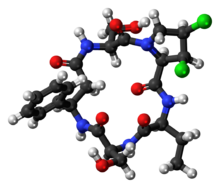Chemistry:Cyclochlorotine

| |

| |
| Names | |
|---|---|
| IUPAC name
1,2-Dichloro-15-ethyl-5,12-bis-hydroxymethyl-9-phenyl-dodecahydro-3a,6,10,13,16-pentaaza-cyclopentac
yclohexadecene-4,7,11,14,17-pentaone
| |
| Other names
Cyclo[(R)-3-phenyl-β-alanyl-L-seryl-(2α,3α,4α)-3,4-dichloro-L-prolyl-L-2-aminobutanoyl-L-seryl]; Yellowed rice toxin
| |
| Identifiers | |
3D model (JSmol)
|
|
| ChemSpider | |
| KEGG | |
PubChem CID
|
|
| UNII | |
| |
| |
| Properties | |
| C24H31Cl2N5O7 | |
| Molar mass | 572.44 g·mol−1 |
Except where otherwise noted, data are given for materials in their standard state (at 25 °C [77 °F], 100 kPa). | |
| Infobox references | |
Cyclochlorotine[1] (CC), also known as islanditoxin[2] is a mycotoxin produced by the fungus Penicillium islandicum[3] that causes liver damage and has carcinogenic properties.[4] Japanese researchers confirmed that it was one of three strains of Penicillin fungi responsible for yellowed rice.[2] It is listed as an IARC Group 3 carcinogen.
Chemically, it is a dichlorinated cyclic peptide.[5] Structurally, the only thing that differentiates cyclochlorotine from the plant-derived astins of Aster tataricus, is replacement of a serine with a second 2-aminobutyrate.[6]
Cyclochlorotine are one of the toxins usually found in foods in the grains group like rice, wheat, soybeans, peanuts, beans, bread, flour, etc. Such foods serve as medium for the growth of molds like Penicillium islandicum which in turn releases toxins like cyclochlorotine etc.[7] Research shows the detailed biosynthesis of Cyclochlorotine which is a multi step mechanism and makes use of a vital component in the last step known as NRPS ( CctN) which helps produce the desired Cyclochlorotine. [6]
References
- ↑ Zhou, ZH; Komiyama, M; Terao, K; Shimada, Y (1994). "Effects of cyclochlorotine on myofibrils in cardiomyocytes and on actin filament bundles in fibroblasts in vitro". Nat. Toxins 2 (6): 378–85. doi:10.1002/nt.2620020607. PMID 7704452.
- ↑ 2.0 2.1 Kushiro, Masayo (2015). "Historical review of researches on yellow rice and mycotoxigenic fungi adherent to rice in Japan". JSM Mycotoxins 65: 12–23. doi:10.2520/myco.65.19.
- ↑ "Toxicology of Penicillium islandicum". Nature 191 (4791): 864–865. 1961. doi:10.1038/191864b0. Bibcode: 1961Natur.191..864..
- ↑ Penicillium islandicum causes hepatic necrosis and has carcinogenic properties
- ↑ Kohei Mizutani; Yusuke Hirasawa; Yoshiko Sugita-Konishi; Naoki Mochizuki; Hiroshi Morita (2008). "Structural and conformational analysis of hydroxycyclochlorotine and cyclochlorotine, chlorinated cyclic peptides from Penicillium islandicum". J. Nat. Prod. 71 (7): 1297–1300. doi:10.1021/np800150m. PMID 18558744.
- ↑ 6.0 6.1 Schafhauser, Thomas; Kirchner, Norbert; Kulik, Andreas; Huijbers, Mieke M. E.; Flor, Liane; Caradec, Thibault; Fewer, David P.; Gross, Harald et al. (2016-11-01). "The cyclochlorotine mycotoxin is produced by the nonribosomal peptide synthetase CctN in Talaromyces islandicus (Penicillium islandicum)" (in en). Environmental Microbiology 18 (11): 3728–3741. doi:10.1111/1462-2920.13294. ISSN 1462-2920. PMID 26954535. https://backend.orbit.dtu.dk/ws/files/123723880/2016_Schafhauser_Cyclochlorotine_EnvMicrobiol_accepted.pdf.
- ↑ Gosh, Anil; Manmade, Awinash; Townsend, James; Bousquet, Ann; Howes, John; Demain, Arnold (June 1978). "Production of Cyclochlorotine and a New Metabolite, Simatoxin, by Penicillium islandicum Sopp". American Society for Microbiology 35 (6): 1074–1078. doi:10.1128/AEM.35.6.1074-1078.1978. PMID 677874.
 |

